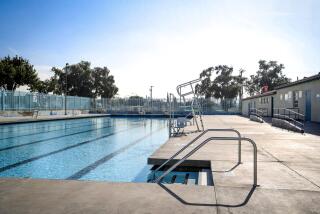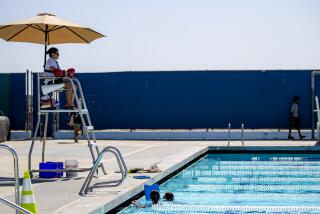Alarmed About Pool Safety
Call David Dukes a worrywart. He doesnât mind. As the father of 3-year-old Michele, Dukes says he is âparanoid about the poolâ in the familyâs backyard in West Los Angeles.
While the pool area is separated from his house by a 5-foot fence with a self-closing gate, âIâm always thinking, âIs the gate closed? Is the gate closed?ââ Dukes says.
His fretting isnât unfounded, experts say. In Orange County, eight children have drowned so far this year--more than double last yearâs rate, says Michelle Feczko, injury-prevention coordinator at Childrenâs Hospital of Orange County. Near-drowning incidents involved 14 more.
In fact, the high number of deaths prompted a proposal for a local ordinance in Huntington Beach that would require a motion-detection-type pool alarm be added when a new pool is built or when a home with a pool is sold.
Pool alarms, designed to sound if a child falls into the water (or crosses a light beam surrounding the poolâs perimeter, in the case of laser-beam alarms) are the newest tool for homeowners seeking to increase the safety of their pool area.
According to the U.S. Consumer Product Safety Commission, nationwide sales of pool alarms have doubled since 1994. There are three basic types:
* Underwater alarms, which detect movement under the waterâs surface.
* Surface alarms, which detect movement on the waterâs surface. (Note that while underwater alarms can be used in conjunction with pool covers, surface alarms canât.)
* Laser-beam perimeter alarms, which detect movement before a child enters the water. The alarm sounds when someone enters the invisible laser-beam path surrounding the pool.
All pool alarms arenât created equal, of course. Some designs can plague homeowners with false alarms brought on by fallen leaves or even a good strong wind. The danger here, safety experts stress, is that homeowners will become annoyed and simply disable the alarm.
Dukes and his wife, Bonnie Kalisher-Dukes, faced this frustration after buying a surface pool alarm, for about $70, from a catalog featuring child-safety products. The alarm was certainly capable of getting the coupleâs attention.
âIt had the volume level of a smoke alarm,â Kalisher-Dukes notes. When her husband was testing it in the pool, âI could hear the alarm while I was going for a walk around the block.â
But the alarm was unreliable and impossible to fine-tune correctly, says Dukes, who adds that sometimes a leaf would trip the alarm, while at other times, a basketball thrown in the water would go unannounced. So the couple is still searching for a reasonably priced, reliable pool alarm. âIt seems like the technology should be there to make one affordable,â Dukes says.
Several reliable pool alarms are available--most for less than $300--experts say. In May 2000, the Consumer Product Safety Commission released the results of its extensive pool-alarm testing. And in an article published in its July issue, Good Housekeeping magazine rated pool alarms that had been tested by its Good Housekeeping Institute engineers.
The commissionâs tests, which did not include laser-beam perimeter alarms, showed that underwater alarms performed most reliably. (One surface alarm, the Pool SOS, performed almost as well. See the accompanying story for details.) Underwater alarms sounded more consistently and were less likely to produce false alarms, testers found. When a test object, intended to simulate the weight of a small child, was pushed into a pool, the underwater alarms did the best job.
While Los Angeles County had reported one backyard pool drowning of a child younger than 5 this year as of May 25, an estimated 10 to 15 near-drownings have occurred, says Billie Weiss, director of injury and violence prevention for the Los Angeles County Department of Health Services.
âAnd thatâs significantly underreported,â she adds, given that only two L.A. County hospitals provide such statistics. In 2000, 10 children died in backyard pools in L.A. County, Weiss says.
She notes that in the late â90s, California passed a law requiring that all homes with new pools have either a barrier (wall or fence) between the house and the pool or have alarms installed on all windows or doors leading to the pool area. Unfortunately, says Weiss, that leaves a lot of older pools that arenât covered by the law, which also doesnât require a pool to be brought up to code when the house is sold.
Such regulations donât go far enough, according to health officials and child-safety organizations.
They recommend that pool owners provide âlayers of protectionâ to keep young children from entering a pool unnoticed. These include walls or fences; self-closing, self-latching gates; door and window alarms; automatic pool covers; and pool alarms. Several safety experts recommended installing at least three separate layers of protection.
Pool alarms should never be relied upon as the only line of defense in preventing a child from drowning, warns the commission. And even after installing various barriers and safety devices, parents still need to closely supervise children and be prepared in case of an emergency.
David Dukes says that a 4-year-old girl once climbed the 6-foot wooden fence that separates his familyâs home and the childâs home, after she used items found in her backyard to create steps. Fortunately, he says, he was outside at the time, spotted the child immediately and âwalked her home and had a serious talk with her parents.â
In this case, disaster was averted, and Dukes became even more convinced of the value of a reliable pool alarm.
In other cases, the results of such childhood explorations are tragic. âA 4-year-old in Fountain Valley scaled a 6-foot fence and drowned in a neighborâs pool,â Feczko says. âNo one layer of protection should ever be considered enough.â
(BEGIN TEXT OF INFOBOX / INFOGRAPHIC)
Making Pools Safer
Pool alarms designed to sound if a child nears or falls into a pool are gaining in popularity. Remote alarms can be located indoors as well.
UNDERWATER ALARM
Transmitter sends out underwater sonar waves
Alarm sounds if rebounding waves are interrupted
*
SURFACE ALARM
Wave action on surface triggers alarm
*
LASER PERIMETER ALARM
Transceiver shoots laser to reflectors surrounding pool
Alarm sounds if beam is broken
*
Kathy Sena is a Manhattan Beach-based freelance writer.
More to Read
Sign up for Essential California
The most important California stories and recommendations in your inbox every morning.
You may occasionally receive promotional content from the Los Angeles Times.










